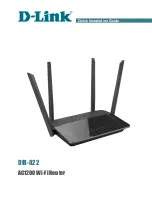
Viper SC+™ IP Router for Licensed Spectrum PN 001-5008-000 Rev. C
| Page 56
Neighbor Discovery
Manual Scan, Auto-Scan,
or
Disabled
Select Manual Scan or Auto-Scan for the method of neighbor discovery or select Disabled to disable neighbor
discovery. Here is what happens when each of these options is selected and then saved. The default setting is
Manual Scan.
Manual Scan
The Viper starts in the Ready state. In the Ready state, the unit is quiet (no neighbor discovery control
messages are sent). If the user clicks Force Scan (button in Control Operations section near the bottom), the
Viper initiates the Scanning for Neighbors state in which the unit is learning about other remote units and the
remote units are learning about the Viper. The Viper goes from the Scanning for Neighbors state to the Saving
Neighbor Table state when it stops learning any new neighbor information for a specified amount of time (this
time interval can be changed using the parameter neighborDiscovery.convergeTimeout, expressed in
milliseconds). In the Saving Neighbor Table state, the content of the neighbor table is stored into nonvolatile
memory. Then, if the unit reboots, the content of the neighbor table is retrieved from this nonvolatile
memory. Finally the Viper goes from the Saving Neighbor Table state to the Ready state.
Auto-Scan
The Viper starts in the Scanning For Neighbors state. In the Scanning For Neighbors state, the Viper is learning
about remote units and the remote units are learning about the Viper. The Viper goes from the Scanning For
Neighbors state to the Ready state when it stops learning any new neighbor information for a specified
amount of time (this value can be changed using the parameter neighborDiscovery.convergeTimeout,
expressed in milliseconds). In the Ready state, the Viper is generating keep-alive packets. (The rate at which
keep-alive packets are generated can be changed using the parameter neighborDiscovery.keepAliveTimeout.)
In the Ready state, the Viper performs broken-link detection. The Viper is monitoring the keep-alive packets of
other units that are one (1) hop away. The Viper knows the interval at which other units are generating their
keep-alive packets. If a unit fails to receive four (4) keep-alive packets in a row from another unit, it removes
that unit from its neighbor table and goes into the Scanning For Neighbors state. If the user clicks Force Scan
(button in the Control Operations section near the bottom), the Viper goes into the Scanning For Neighbors
state. If any remote units initiate the Scanning For Neighbors state, the local Viper also goes into the Scanning
For Neighbors state.
Disabled
The neighbor discovery module is disabled and the Viper will not learn about any new neighbors. It will not
generate any keep-alive packets.
CalAmp recommends the following.
Auto-Scan
This feature is only for projects that contain no more than ten (10) radios with very strong RF paths.
Manual Scan
This should only be used to enroll all the remotes for the first time, then disable. After a Manual Scan,
disabling the discovery mode locks all routes into place. Review all Neighbor entries and edit them if necessary
to ensure that they are the correct and most reliable RF paths and also delete RF paths that are not required.
For example, in most master and remote polling configurations, the remotes only need to have the master in
their Neighbor Tables.
















































